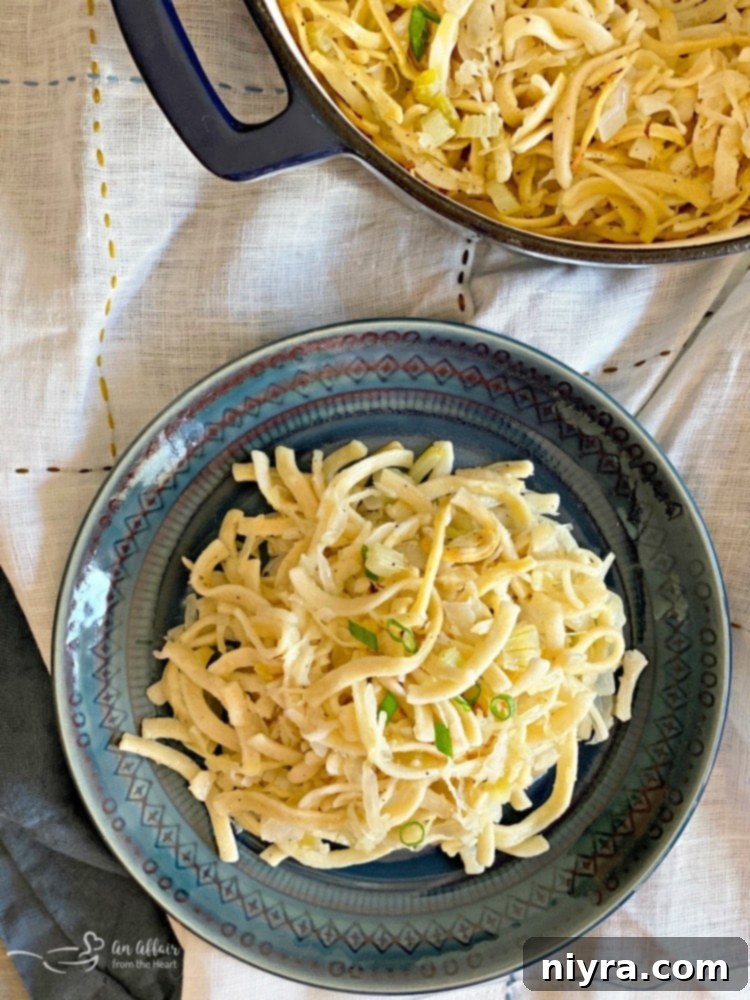Discover the comforting taste of traditional Polish cuisine with this delightful meatless casserole, featuring tender Kluski noodles, sautéed onions, tangy sauerkraut, and crisp celery, all fried in butter and baked to golden perfection.
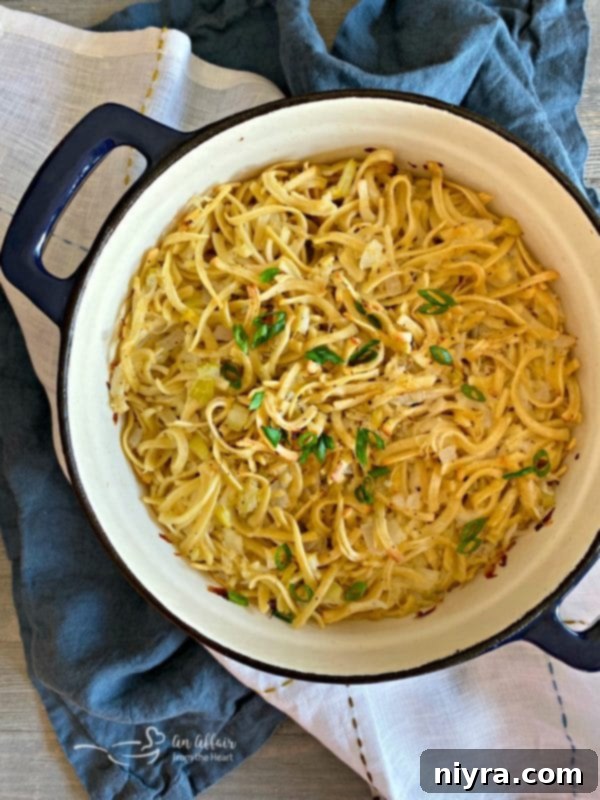
While my roots are deeply Polish, the language itself remains a beautiful mystery to me. Naming this traditional dish, therefore, presented a charming little challenge. For many, the simple “Polish Noodles & Sauerkraut” rolls off the tongue far more easily than “Kluski Kapusta Kiszona” or “Polish Haluski.” So, while we’ll explore the rich history and authentic terminology behind this beloved recipe, for all practical purposes and easy enjoyment, let’s affectionately call it our Polish Noodles & Kraut Casserole. This dish isn’t just a recipe; it’s a journey into the heartwarming essence of Polish comfort food.
This culinary exploration is brought to you with the generous support of Frank’s Kraut. My unwavering affection for their delicious sauerkraut spans a lifetime, and all opinions expressed here are entirely my own.
SOME OF THE LINKS BELOW ARE AFFILIATE LINKS. AS AN AMAZON ASSOCIATE AND AN AFFILIATE FOR OTHER BRANDS, I EARN A SMALL COMMISSION FROM QUALIFYING PURCHASES. REST ASSURED, I ONLY ENDORSE PRODUCTS I TRULY LOVE AND BELIEVE YOU WILL APPRECIATE TOO. FOR A COMPLETE OVERVIEW OF MY DISCLOSURE POLICY, PLEASE CLICK HERE.

Embrace the Warmth: Polish Noodles & Kraut for Cooler Days
As the temperatures drop and crisp air fills the autumn evenings, our thoughts naturally drift towards hearty, soul-warming comfort food. What could be more comforting than a golden casserole crafted with rich, buttery egg noodles? This dish is a true “stick-to-your-ribs” meal, satisfying and deeply flavorful. While it’s completely meatless, its substantial ingredients make it incredibly filling, perfect as a standalone main course. It also shines brilliantly as a savory side, especially alongside traditional smoked Polish sausage. Planning a potluck or family gathering? This casserole is always a crowd-pleaser and never fails to disappear quickly!
What Exactly is Polish Noodles & Kraut?
At its heart, this dish is a beautiful symphony of flavors: tender noodles, typically Kluski, pan-fried in generous butter with aromatic onions and robust sauerkraut. My personal touch includes a touch of celery, which I find complements the onion perfectly, adding a subtle crunch and fresh note. Some variations might incorporate mushrooms, contributing an earthy depth that many adore. The simplicity of the ingredients belies the incredible depth of flavor achieved through careful preparation.
As mentioned earlier, the dish carries several names, which often leads to delightful confusion! This linguistic diversity is likely why many of us in the United States affectionately refer to this traditional European staple as “Noodles & Kraut” or “Noodles & Cabbage.” Let’s demystify some of these terms:
Understanding the Terminology: Haluski, Kluski, Kapusta, and Kiszona
What is Haluski?
Haluski is a widely recognized dish often associated with Polish and Slovakian cuisines, though Ukrainian and Hungarian traditions also lay claim to similar variations. Essentially, it’s a simple yet delicious preparation of noodles, onions, and cabbage, all pan-fried together in butter until golden and tender. It’s the rustic, comforting dish that brings families together across Eastern Europe.
What is Kluski? [KLOOSS-kee]
In Polish, “Kluski” is a versatile term that translates to “dumplings” or “noodles.” Kluski noodles are typically thicker and more robust than standard Italian pasta, often made from flour and water. While similar to egg noodles in texture and application, true Kluski might omit the egg. However, in many recipes, particularly in the US, “Kluski noodles” are often synonymous with wide egg noodles, making them easily interchangeable for convenience without sacrificing the authentic feel of the dish.
What is Kapusta? [kah-POOS-tah]
Kapusta is simply the Polish word for “cabbage.” When referring to a traditional dish, “Kapusta” often implies braised cabbage, usually cooked with onions, mushrooms, and garlic, creating a deeply savory and tender side or main component.
What is Kiszona?
Adding another layer to our understanding, “Kiszona” directly translates to “sour” or “pickled,” making “Kapusta Kiszona” the Polish term for “sour cabbage” – or as we know it, sauerkraut. This fermented cabbage is a cornerstone of Eastern European cuisine, celebrated for its tangy flavor and probiotic benefits.
So, you see, navigating the linguistic nuances without fluency can be quite an adventure! That’s why I’ve settled on the straightforward “Polish Noodles & Sauerkraut” for this recipe, a name that perfectly encapsulates its essence. Interestingly, this isn’t a dish I vividly recall from my own childhood, at least not in this traditional form. However, my daughter’s fiancé, who boasts both Polish and Lithuanian heritage, enjoys a very similar meal every Easter, which they affectionately call “Polish Spaghetti.” It’s fascinating how culinary traditions evolve and find new expressions across generations and regions.

This cherished photograph captures a moment from my very first Christmas, with me nestled beside my maternal great-grandmother. She embarked on a remarkable journey to the United States from Tarnow, Poland, at the tender age of 16. Her family eventually found a new home in Nebraska, where she met and married my Great Grandfather, and together they raised their family in the quaint town of Ashton, Nebraska. I fondly remember visiting her when I was in 6th grade, not long before she passed away. Her command of English was limited, making my grandmother’s presence invaluable for translating our conversations. Those visits were a beautiful bridge to my heritage, even if words sometimes needed a little help.
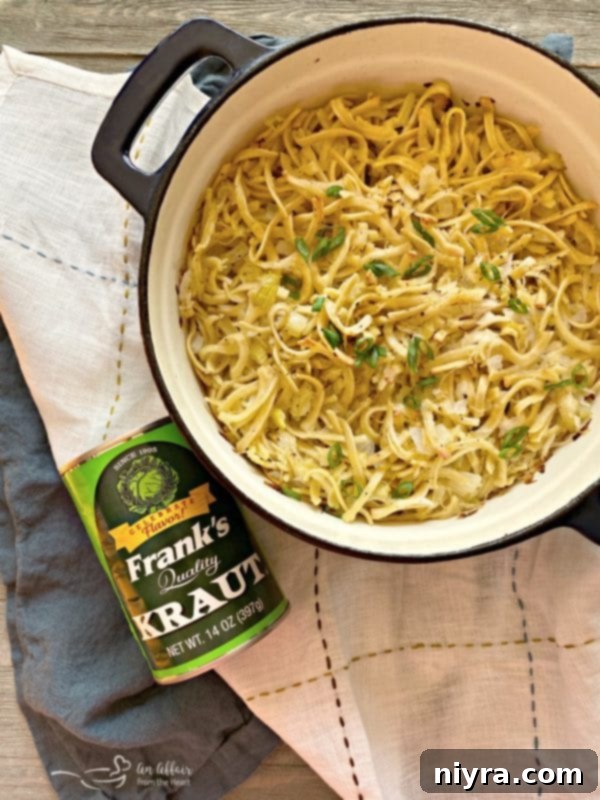
When Frank’s Kraut approached me to develop a comforting casserole-style dish to usher in the cooler temperatures, this delightful noodle dish immediately sprang to mind. My kitchen has seen countless recipes featuring their consistently delicious sauerkraut. Among our family’s absolute favorites is this incredibly savory Reuben Casserole, a true testament to the versatility of good sauerkraut.
For a long time, my culinary explorations with sauerkraut leaned more towards German traditions, particularly dishes suited for Oktoberfest. However, in recent months, I’ve found myself delving deeper into the rich tapestry of my Polish heritage. This journey truly intensified last month when I shared my family’s recipe for Polish Sauerkraut Soup, or Kapusniak, sparking a renewed passion for uncovering and sharing these ancestral flavors.
Explore More Sauerkraut Recipes on My Pinterest Board
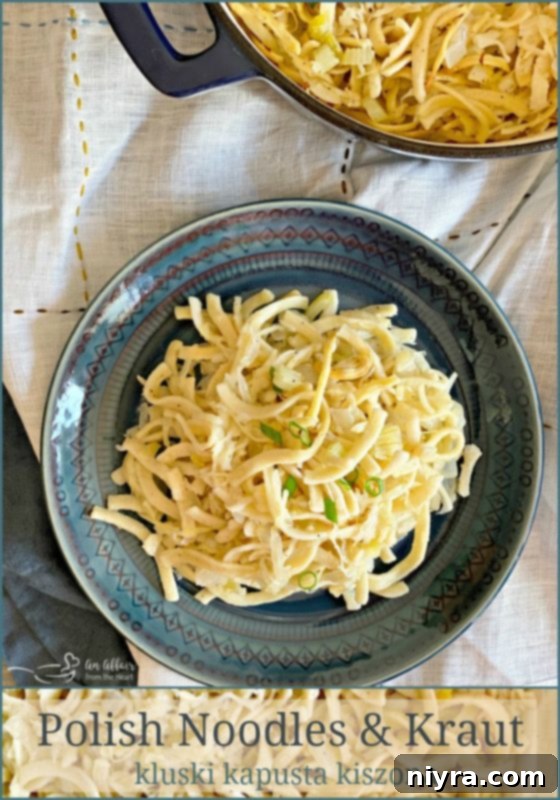
^Love this recipe? Pin it for later!^
If this enticing recipe has captured your imagination, be sure to save it to your favorite Pinterest board! This way, it will be easy to find when you’re ready to whip up this delicious Polish Noodles & Sauerkraut casserole.
Simple Ingredients for a Flavorful Dish:
One of the beauties of traditional cuisine is often its simplicity, and this Polish Noodles & Sauerkraut recipe is no exception. With just a few staple ingredients, you can create a meal brimming with authentic flavor. Here’s what you’ll need:
- **Butter:** The foundation of flavor, providing richness and helping to beautifully brown the vegetables and noodles.
- **Onion:** Sweetens as it cooks, offering a crucial aromatic base.
- **Celery:** My personal addition for a subtle crunch and a fresh, herbaceous counterpoint to the richness.
- Frank’s Kraut: The star of the show, delivering that essential tangy, fermented cabbage flavor. Its quality is key to the dish’s success.
- **Kluski Noodles:** The hearty, comforting noodles that soak up all the wonderful buttery flavors.
- **Salt & Pepper:** To taste, enhancing all the natural flavors.

While the celery isn’t visible in this particular prep shot, I decided to incorporate it at the last minute during development, and the results were absolutely delightful! Its fresh, crisp notes really elevate the dish, adding another layer of texture and taste.
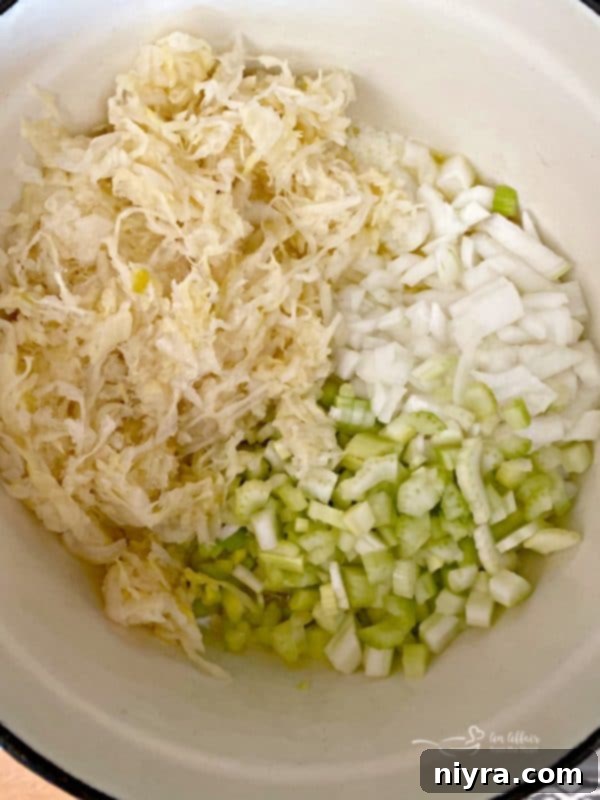
The cooking process begins by melting a generous amount of butter in a sturdy pan. For this, I highly recommend a cast iron Dutch oven. Its ability to retain heat evenly and transition seamlessly from stovetop to oven makes it ideal for this casserole. Once the butter is shimmering, add the chopped celery, onion, and drained sauerkraut. Cook this savory mixture, stirring frequently, until the onion becomes beautifully translucent and the celery softens, usually about 20 minutes. While this flavorful base is developing, in a separate pot, cook your Kluski noodles according to package directions, typically in salted boiling water, then drain them thoroughly. This parallel cooking method ensures both components are perfectly prepared before combining.
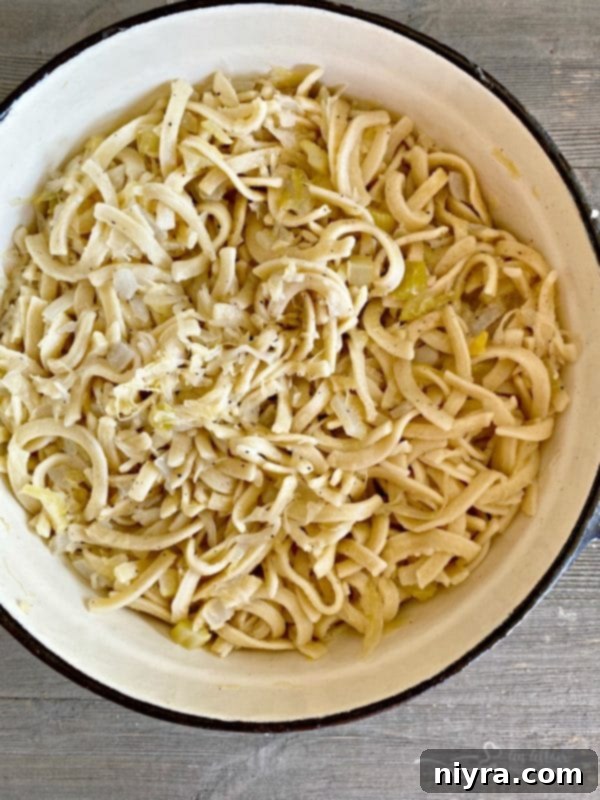
Once the sauerkraut and vegetable mixture is ready, stir in the cooked Kluski noodles, along with a pinch of salt and pepper to taste, ensuring everything is thoroughly combined. Transfer the entire mixture into your oven-safe dish (if not already using a Dutch oven). Place it into the preheated oven to bake. As it bakes, the noodles on top will gradually turn a beautiful golden brown, developing a delightful slight crispness. This toasted noodle layer is always a family favorite in any baked pasta dish – that little bit of crunch is simply irresistible!
Why Frank’s Kraut is My Go-To Choice

Let’s take a moment to discuss my absolute favorite sauerkraut: Frank’s Kraut. This isn’t just a brand for me; it’s a taste of home. It’s the sauerkraut I grew up with, and frankly, the only one I’ve ever cooked with as an adult. Its consistent quality and perfectly balanced tang are simply unmatched.
Frank’s Kraut is conveniently available in cans, jars, and my personal favorite, the poly bags. When I purchase the two-pound poly bags, I always stock up, buying extra to store in the freezer. And let me tell you, if you’ve never tried frozen kraut, you’re missing out – it’s incredibly good! Once defrosted, I use what I need for my recipe, and any remaining sauerkraut is easily transferred to a mason jar and stored in the fridge, ready for its next culinary adventure.
Frank’s Kraut truly stands out as one of the most versatile vegetables you can find on grocery shelves. It not only adds a vibrant zest to countless meals but also packs a nutritional punch. Crafted with just three simple ingredients – cabbage, salt, and water – it’s naturally low in calories, gluten-free, and comes in a variety of delicious flavors. To delve deeper into the world of Frank’s Kraut and explore their full range of products and recipes, I highly recommend visiting their comprehensive website.
LOVE SAUERKRAUT? Dive Deeper!
Are you curious to learn everything there is to know about this fascinating fermented food? From its ancient origins and traditional preparation methods to a treasure trove of incredible sauerkraut recipes, my Ultimate Guide to Sauerkraut is your comprehensive resource.
Stay connected with Frank’s Kraut across their social media channels for a continuous stream of delicious recipes and inspiration throughout the year. Follow them on Facebook, Twitter, Pinterest, and Instagram for all things sauerkraut!
Discover All My Sauerkraut Recipes!
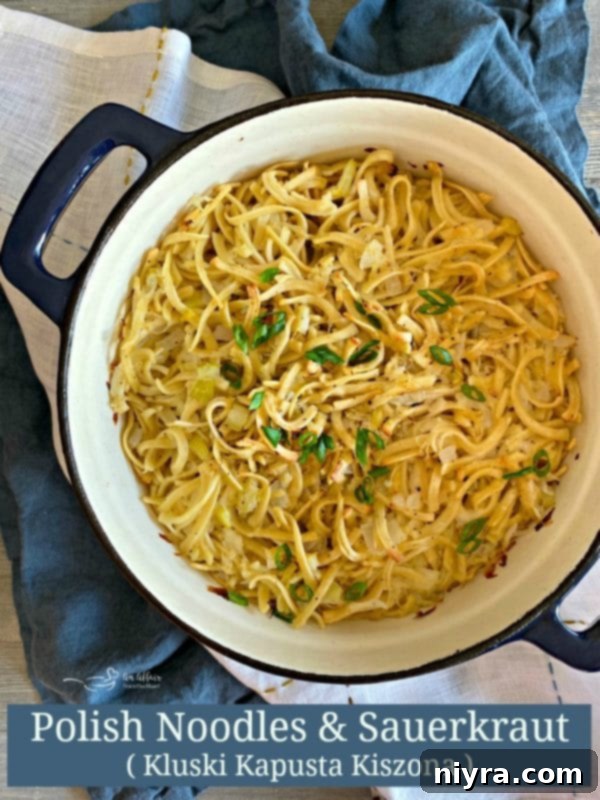
Now, let’s get right to the heart of the matter – the full recipe for this incredible Polish Noodles & Sauerkraut! 
LIKE THIS RECIPE?
Don’t forget to give it a ⭐️⭐️⭐️⭐️⭐️ star rating and
leave a comment below the recipe!
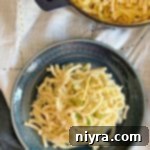
Print Recipe
Polish Noodles & Sauerkraut (Kluski Kapusta Kiszona)
Equipment
- Franks Kraut, Shredded, Canned, 14-Ounce (Pack of 24)
- Lodge 6 Quart Enameled Cast Iron Dutch Oven. Classic Red Enamel Dutch Oven (Island Spice Red)
Ingredients
- 1 stick butter
- 1 large onion chopped
- 2 cups Frank’s Kraut drained (unrinsed)
- 1/2 cup celery chopped
- 1 16 ounce package Kluski noodles, cooked
Instructions
- Preheat oven to 350 degrees F (175°C).
- In a Dutch oven or large oven-safe skillet, melt the butter over medium-high heat. Add the drained sauerkraut, chopped onion, and celery. Cook, stirring frequently, until the onion is translucent and the celery is tender, which typically takes about 20 minutes.
- While the sauerkraut mixture is cooking, bring a large pot of salted water to a rolling boil. Add your Kluski noodles and cook according to package instructions until al dente. Drain the noodles thoroughly.
- Stir the cooked and drained Kluski noodles into the sauerkraut and vegetable mixture in the Dutch oven, ensuring everything is well combined. Season with salt and pepper to taste.
- Cover the Dutch oven or skillet and bake for 30 minutes in the preheated oven. After 30 minutes, remove the lid and continue baking for another 15 minutes, or until the top noodles are golden brown and slightly crispy.
- Serve the Polish Noodles & Sauerkraut directly from the pot. Garnish with fresh scallions, if desired, for an extra burst of flavor and color.
Notes
Nutrition
